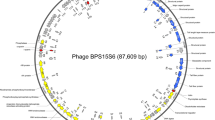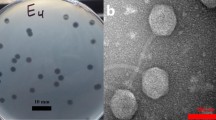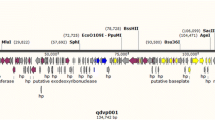Abstract
Shewanella putrefaciens has been identified as a specific spoilage organism commonly found in chilled fresh fish, which contributes to the spoilage of fish products. Limiting S. putrefaciens growth can extend the shelf-life of chilled fish. Endolysins, which are lytic enzymes produced by bacteriophages, have been considered an alternative to control bacterial growth, and have been useful in various applications, including food preservation. We report here, for the first time, the complete genome sequence of a novel phage Spp001, which lyses S. putrefaciens Sp225. The Spp001 genome comprises a 54,789-bp DNA molecule with 67 open reading frames and an average total G + C content of 49.42 %. In silico analysis revealed that the Spp001 open reading frames encode various putative functional proteins, including an endolysin (ORF 62); however, no sequence for genes encoding the holin polypeptides, which work in concert with endolysins, was identified. To examine further the lytic activity of Spp001, we analyzed the lytic enzyme-containing fraction from phages released at the end of the phage lytic cycle in S. putrefaciens, using diffusion and turbidimetric assays. The results show that the partially purified extract contained endolysin, as indicated by a high hydrolytic activity towards bacterial peptidoglycan decrease in the OD590 value by 0.160 in 15 min. The results will allow further investigation of the purification of natural Spp001 endolysin, the extension of Spp001 host range, and the applications of the phage-encoded enzymes.





Similar content being viewed by others
References
Basir N, Yong AML, Chong VH (2012) Shewanella putrefaciens, a rare cause of splenic abscess. J Microbiol Immunol Infect 45:151–153
Bradford MM (1976) A rapid and sensitive method for the quantitation of microgram quantities of protein utilizing the principle of protein-dye binding. Anal Biochem 72:248–254
Briers Y, Volckaert G, Cornelissen A, Lagaert S, Michiels CW, Hertveldt K, Lavigne R (2007) Muralytic activity and modular structure of the endolysins of Pseudomonas aeruginosa bacteriophages phi KZ and EL. Mol Microbiol 65:1334–1344
Brink AJ, Van Straten A, van Rensburg AJ (1995) Shewanella (Pseudomonas) putrefaciens bacteremia. Clin Infect Dis 20:1327–1332
Callewaert L, Walmagh M, Michiels CW, Lavigne R (2011) Food applications of bacterial cell wall hydrolases. Curr Opin Biotechnol 22:164–171
Celia LK, Nelson D, Kerr DE (2008) Characterization of a bacteriophage lysin (Ply700) from Streptococcus uberis. Vet Microbiol 130:107–117
Clarke AJ (1993) Extent of peptidoglycan O acetylation in the tribe Proteeae. J Bacteriol 175:4550–4553
Cof Fey B, Mills S, Coffey A, McAuliffe O, Ross RP (2010) Phage and their lysins as biocontrol agents for food safety applications. Annu Rev Food Sci Technol 1:449–468
Durdu B, Durdu Y, Gulec N, Islim F, Biçer M (2012) A rare cause of pneumonia: Shewanella putrefaciens. Mikrobiyol Bul 1:117
Fenton M, Ross P, McAuliffe O, O’Mahony J, Coffey A (2010) Recombinant bacteriophage lysins as antibacterials. Bioeng Bugs 1:9–16
Fischetti VA, Gotschlich EC, Bernheimer AW (1971) Purification and physical properties of group C streptococcal phage-associated lysin. J Exp Med 133:1105–1117
Fischetti VA (2005) Bacteriophage lytic enzymes: novel anti-infectives. Trends Microbiol 13:491–496
Fonnesbech B, Frokiaer H, Gram L, Jespersen CM (1993) Production and specificity of poly- and monoclonal antibodies raised against Shewanella putrefaciens. J Appl Bacteriol 74:444–451
Gaeng S, Scherer S, Neve H, Loessner MJ (2000) Gene cloning and expression and secretion of Listeria monocytogenes bacteriophage-lytic enzymes in Lactococcus lactis. Appl Environ Microbiol 66:2951–2958
Ganegama AG, Cridge AG, Dias-Wanigasekera BM, Cruz CD, McIntyre L, Liu R, Flint SH, Mutukumira AN (2013) Effectiveness of phages in the decontamination of Listeria monocytogenes adhered to clean stainless steel, stainless steel coated with fish protein, and as a biofilm. J Ind Microbiol Biotechnol 40:1105–1116
Gram L, Huss HH (1996) Microbiological spoilage of fish and fish products. Int J Food Microbiol 33:121–137
Kakikawa M, Yokoi KJ, Kimoto H, Nakano M, Kawasaki K, Taketo A, Kodaira K (2002) Molecular analysis of the lysis protein Lys encoded by Lactobacillus plantarum phage phig1e. Gene 299:227–234
Kang HW, Kim JW, Jung TS, Woo GJ (2013) wksl3, a New biocontrol agent for Salmonella enterica serovars enteritidis and typhimurium in foods: characterization, application, sequence analysis, and oral acute toxicity study. Appl Environ Microbiol 79:1956–1968
Kropinski AM, Mazzocco A, Waddell TE, Lingohr E, Johnson RP (2009) Enumeration of bacteriophages by double agar overlay plaque assay. Methods Mol Biol 501:69–76
Lopez R, Garcia E, Garcia P (2004) Enzymes for anti-infective therapy: phage lysins. Drug Discov Today Ther Strateg 1:469–474
Leong J, Mirkazemi M, Kimble F (2000) Shewanella putrefaciens hand infection. Aus New Z J Surg 70:816–817
Li P, Chen B, Song Z, Song Y, Yang Y, Ma P, Wang H, Ying J, Ren P, Yang L, Gao G, Jin S, Bao Q, Yang H (2012) Bioinformatic analysis of the Acinetobacter baumannii phage AB1 genome. Gene 507:125–134
Lim J, Shin H, Kang D, Ryu S (2012) Characterization of endolysin from a Salmonella Typhimurium-infecting bacteriophage SPN1S. Res Microbiol 163:233–241
Loessner MJ, Wendlinger G, Scherer S (1995) Heterogeneous endolysins in Listeria monocytogenes bacteriophages: a new class of enzymes and evidence for conserved holin genes within the siphoviral lysis cassettes. Mol Microbiol 16:1231–1241
Loessner MJ (2005) Bacteriophage endolysins: current state of research and applications. Curr Opin Microbiol 8:480–487
Lu Z, Breidt F Jr, Fleming HP, Altermann E, Klaenhammer TR (2003) Isolation and characterization of a Lactobacillus plantarum bacteriophage from a cucumber fermentation. Int J Food Microbiol 84:225–235
Meng L, Hong L, Naseem MK, Jingxue W, Linghong K (2013) Effects of bacteriophage on the quality and shelf life of Paralichthys olivaceus during chilled storage. J Sci Food Agric. doi:10.1002/jsfa.6475
Nelson D, Loomis L, Fischetti VA (2001) Prevention and elimination of upper respiratory colonization of mice by group A streptococci by using a bacteriophage lytic enzyme. Proc Natl Acad Sci USA 98:4107–4112
Niu YD, Stanford K, Kropinski AM, Ackermann HW, Johnson RP, She YM, Ahmed R, Villegas A, McAllister TA (2012) Genomic, proteomic and physiological characterization of a T5-like bacteriophage for control of Shiga toxin-producing Escherichia coli O157:H7. PLoS One 7:e34585
Pagani L, Lang A, Vedovelli C, Moling O, Rimenti G, Prister AR, Mian P (2003) Soft tissue infection and bacteremia caused by Shewanella putrefaciens. J Clin Microbiol 41:2240–2241
Pastagia M, Euler C, Chahales P, Fuentes-Duculan J, Krueger JG, Fischetti VA (2011) A novel chimeric lysin shows superiority to mupirocin for skin decolonization of methicillin-resistant and -sensitive Staphylococcus aureus strains. Antimicrob Agents Chemother 55:738–744
Quan-you G, Xian-shi Y, Zhong X, Jian-jun W (2007) Bacterial flora changes on cultured Pseudosciaena crocea during chilled storage (Chinese). J Fish Sci China 301–308
Raina JL (1981) Purfication of Streptococcus group C bacteriophage lysin. J Bacteriol 145:661–663
Son B, Yun J, Lim JA, Shin H, Heu S, Ryu S (2012) Characterization of LysB4, an endolysin from the Bacillus cereus-infecting bacteriophage B4. BMC Microbiol 12:33
Strating H, Clarke AJ (2001) Differentiation of bacterial autolysins by zymogram analysis. Anal Biochem 291:149–154
Valence F, Lortal S (1995) Zymogram and preliminary characterization of Lactobacillus helveticus autolysins. Appl Environ Microbiol 61:3391–3399
Walmagh M, Briers Y, Dos Santos SB, Azeredo J, Lavigne R (2012) Characterization of modular bacteriophage endolysins from myoviridae phages OBP, 201 phi 2-1 and PVP-SE1. PLOS One 7
Walmagh M, Boczkowska B, Grymonprez B, Briers Y, Drulis-Kawa Z, Lavigne R (2013) Characterization of five novel endolysins from Gram-negative infecting bacteriophages. Appl Microbiol Biotechnol 97:4369–4375
Wang Y, Sun JH, Lu CP (2009) Purified recombinant phage lysin LySMP: an extensive spectrum of lytic activity for swine streptococci. Curr Microbiol 58:609–615
Whichard JM, Weigt LA, Borris DJ, Li LL, Zhang Q, Kapur V, Pierson FW, Lingohr EJ, She Y, Kropinski AM (2010) Complete genomic sequence of bacteriophage felix O1. Viruses 2:710–730
Yafu X, Hong L, Qian Z, Liangliang T, Shuo Z, Jianxin S, Limin C (2010) Characterization of chicken egg yolk antibodies against dominant spoilage organisms in Paralichthys olivaceus during cold storage (Chinese). Food Sci 23:27
Yoong P, Schuch R, Nelson D, Fischetti VA (2004) Identification of a broadly active phage lytic enzyme with lethal activity against antibiotic-resistant Enterococcus faecalis and Enterococcus faecium. J Bacteriol 186:4808–4812
Yuan Y, Peng Q, Gao M (2012) Characteristics of a broad lytic spectrum endolysin from phage BtCS33 of Bacillus thuringiensis. BMC Microbiol 12:297
Zimmer M, Vukov N, Scherer S, Loessner MJ (2002) The murein hydrolase of the bacteriophage phi 3626 dual lysis system is active against all tested Clostridium perfringens strains. Appl Environ Microbiol 68:5311–5317
Acknowledgments
This work was supported by the National Natural Science Funding of China (Grant No. 31071540), the “National Science & Technology Pillar Program (2012BAD28B05)” and the Earmarked Fund for Modern Agroindustry Technology Research System (nycytx-50).
Author information
Authors and Affiliations
Corresponding author
Rights and permissions
About this article
Cite this article
Han, F., Li, M., Lin, H. et al. The novel Shewanella putrefaciens-infecting bacteriophage Spp001: genome sequence and lytic enzymes. J Ind Microbiol Biotechnol 41, 1017–1026 (2014). https://doi.org/10.1007/s10295-014-1438-z
Received:
Accepted:
Published:
Issue Date:
DOI: https://doi.org/10.1007/s10295-014-1438-z




